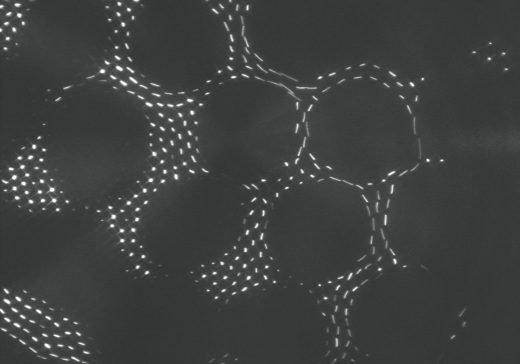Theory Group
Annual Report 2006
Scientific Results2.5 Complex Plasmas
Complex or dusty plasmas are plasmas, i.e. ionized gases, containing microparticles, e.g. dust grains. In low-temperature discharge plasmas these microparticles collect mainly electrons on their surface. The charge of the microparticles is typically between 1000 and 100.000 elementary charges. The typical interparticle distance is of the order 100 µm. The microparticles build a strongly-coupled system, i.e., their interaction energy is larger than their thermal energy. Due to screening of the particle charge within the plasma the interaction potential is of the Yukawa type (screened Coulomb potential).
In 1986 it was predicted that the microparticles in a complex plasma can due to their strong interaction arrange themselves in regular structures, the so called plasma crystal. In 1994 such a plasma crystal was generate and observed for the first time within a collaboration between the MPE and the German Space Agency DLR. For this purpose a radio-frequency discharge in a small plasma chamber is used to produce the background plasma in a noble gas (e.g. Argon) at pressures of the order of 0.1 to 1.0 mbar. Afterwards monodisperse plastic spheres with diameters of the order 1 to 10 µm are injected. The charged microparticles are then levitated and confined by the electric filed surrounding the plasma in the plasma sheath above the lower electrode. The microparticles, illuminated by a laser sheet, are observed by a camera. In this way, complex plasmas, e.g. in the crystalline phase (Fig. 1), can be investigated directly.

Fig. 1: Microparticles (white dots, top view) illuminated by a laser flowing around several voids in a magnetized complex plasma.
The formation and melting of plasma crystals, their structure, phonon spectra etc. can be observed on the microscopic and kinetic level. Also the liquid phase is of great interest, in which for example shear flow and turbulence can be studied. Therefore complex plasmas are ideal models for understanding crystallization and other dynamical processes (phase transitions, instabilities, dispersion relations, etc.) on the microscopic level in solid state, fluid, and plasma physics. Other applications of complex plasmas can be found in astrophysics and plasma technology. There are many situations in space where dusty plasmas occur. Among them are comets, planetary rings, accretion disks, interstellar clouds and others. Plasma etching and coating, on the other hand, is a widely used technology, e.g. for producing microchips. In these plasma reactors dust arises and grows, leading to possible contamination problems. Therefore a detailed understanding of the origin and growth of dust and its interaction with the plasma is desirable. Furthermore dust plays a role in fusion reactors. Due to this variety of applications, complex plasma physics is a rapidly growing field.
In the laboratory on earth many experiments are hampered by gravity effects, restricting the system to the plasma sheath. Hence often only small, quasi two-dimensional systems can be produced and gravity influences the structure and dynamics of the microparticle system. Furthermore, the background plasma in the plasma sheath is rather complicated (non-neutral and anisotropic) which renders the interpretation of the experiments difficult. Therefore we perform microgravity experiments with complex plasmas since 1996 in sounding rockets and parabolic flights. Since 2001 (see section 3.4.) complex plasmas are also investigated on board of the International Space Station ISS in cooperation between MPE and the Institute for High Energy Densities (IHED) in Moscow.
At MPE complex plasmas are investigate experimentally and theoretically. Laboratory experiments, e.g. the properties and behaviour of complex plasmas in strong magnetic fields (Fig. 1) or in a dc discharge, as well as microgravity (parabolic flight campaigns, ISS) experiments are constructed and performed. Analytic models and numerical simulations are developed for an understanding of the physical processes.
In the following we report on two recent results of our investigations of complex plasmas, namely the non-Newtonian behaviour of complex plasma fluids and the recrystallization of a two-dimensional plasma crystal.
Updated: 2007-10-18
Contact: Michael Kretschmer